Can You Have Makeup In Medieval
Medieval cosmetics and beauty routine
When you imagine a medieval homo or woman, what practice you lot see? Foul teeth? Greasy hair? Dingy, bumpy skin? Hairy armpits and sweat stench?
Well, for some of them, this might have been truthful. For some people today, this is nevertheless truthful. But medieval sources prove, that it could be and has been different for large parts of the population. Medieval people know far more than we recollect today.
In this article I want to talk about aspects of (female person) beauty routine and cosmetics, as we find them in medieval sources (mainly the Trotula).
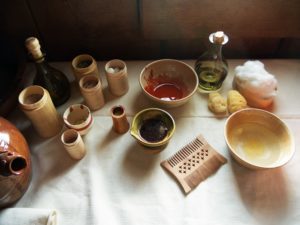
Apropos all the recipes I mention: I slightly changed some of them since many of them exercise their task in their original mixture merely on a long term utilize will affect your health quite badly. Others are working with 3 usefull ingredients and one absolutely absurd ingredient, which does not contribute to the consequence in any way and of which I tin not say, whether it is in the recipe due to faulty copying the original texts, due to superstitious reasons or simply considering the author had no clue.
Also I simply left out a whole bunch of recipes which seemed to have no noticable utilise or impact from a mod indicate of science.
The daily morning routine every bit described in some of the texts we documented in this video:
The discipline areas:
- Daily wash
- Deodorant
- Hair care
- Hair removal
- Dental hygiene
- Nailcare
- Ear spoons
- Decorative cosmetics
- Sun screen
- Jewellery and habiliment
- Farther data
Daily wash
The rough nuts: Bathing was not a daily addiction in late medieval fourth dimension. But the same goes for most of society up until the 50s. A quick bath with hot h2o and a sponge or washcloth was sill mutual in my grandmother'southward time. Medieval people visited the bathhouse perchance once or twice a calendar week. We explicate a matter or ii virtually Viennese bath houses in our video „In the bathhouse" and in Nikolaus' accompanying article.
For daily aseptic routine, the Trotula advise to their female readers, to wash the body with cloth or sponges and accept a steam bath.
„Have called-for hot tiles and stones and with these placed in the steambath, allow the woman sit down in it. […] Then allow hot water be poured in so that steam is produced, and permit thewoman sit down upon information technology well covered with cloths so that she sweats. And when she has well sweated, let her enter hot h2o and wash herself very well, and thus let her leave from the bath and wipe herself off well with a linen cloth."
For washing, oftentimes a washbowl and a jug was in utilise.
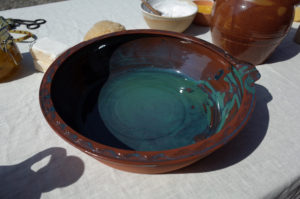
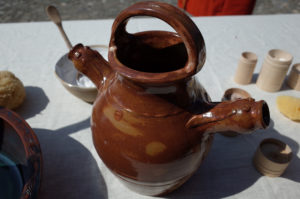
Towels were in utilise to dry the body. We know this from many finds and original pictures of medieval towels in their very feature shawl-like form featuring woven-in blue or black stripes. Specially famous are italian Perugia-Towels and their beautiful bluish and white patterns.
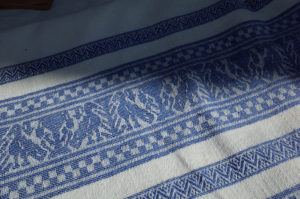
The face gets special attention in the Trotula. You lot are supposed to wash your face with french soap and and then do a face scrub with wheat bran. Something yous still do today. Wheat bran is a prissy culling to modern peeling lotions containing nasty microplastics.
„ First of all, let her wash her face very well with French soap and with warm water, and with a straining of bran permit her wash herself in the bath."
By the style, they besides mention a face up mask made with wheat starch. Also something still done today .
After washing the face, thorough skin care is necessary, and then our lady uses a delicate hydrating cream subsequently a recipe from the roman physician Galien. Why a roman recipe? Considering Galien'southward works are notwithstanding taught in the Viennese University in mid 14th century.
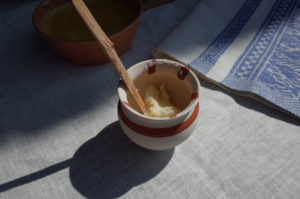
It is fabricated from bees wax, rose oil and almond oil and feels really nice on the skin.
On her temples, our lady wears a fleck of violet-ointment confronting headaches.
Deodorant:
Then at present that nosotros are all fresh and clean, nosotros desire to keep information technology that fashion. And the Trotula also offer a recipe for that purpose:
„There are some women who have sweat that stinks beyond measure. For these we prepare a fabric dipped in wine in which in that location have been boiled leaves of bilberry"
We don't know, how exactly this deodorant is supposed to work. We think it might be due to the antibacterial backdrop of the vino and the adstringent tanning agents in the bilberry leaves that cause the pores to tighten. So it may very well exist a solution for a few hours.
Hair care:
To wash the hair (which certainly was not done every twenty-four hours), lye from ash was nearly probable used. The Trotula mention ash from vie stems to launder the hair.
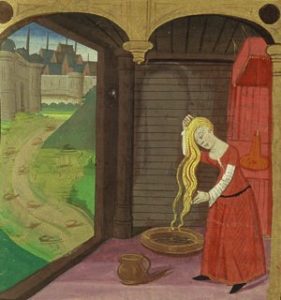
„After leaving the bathroom, let her adorn her hair, and showtime of all let her wash it with a cleanser such as this. Take ashes of burnt vine, […] boil the chaff and the sowbread in water. […] Let a pot having at its base two or three pocket-size openings be filled. Let the water […] be poured into the pot, so that it is strained by the modest openings. With this cleanser permit the adult female wash her caput. After the washing, let her leave it to dry past itself, and her pilus will be gilt and shimmering."
Afterwards, some medieval conditioner can be used, in the original recipe this is made from lizzard grease and some overnice smelling substances. But even if you could get the lizzard grease, it would non do any better work than any other kind of oil or grease to make the pilus shiny and good for you. Nosotros used olive oil, spiced with lemon pare.
To make the hair smell fifty-fifty nicer, y'all can use this hair pulverization:
„Only when she combs her pilus, allow her have this powder. Take some dried roses, clove, nutmeg, watercress, and galangal. Let all these, powdered, exist mixed with rose water. With this h2o let her sprinkle her pilus and comb it with a rummage dipped in this same water then that information technology will smell meliorate."
The powder smells really squeamish and kind of oriental. Every bit a modern human, even I could imagine smelling similar that occasionally.
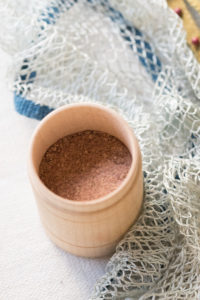
And you tin can do fifty-fifty more to get out a lovely smell in the air your beloved smells when you walk by:
„Also, noblewomen shouldwear musk in their pilus,or clove,or both, only take care that it not be seen by anyone. Also the veil with which the caput is tied should exist put on with cloves and musk, nutmeg, and other sweet-smelling substances."
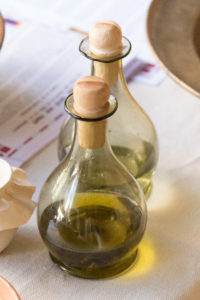
More near hair intendance and hair styles hither.
Hair removal:
Concerning the residual of the trunk pilus, the hairless body was not unknown to medieval people.
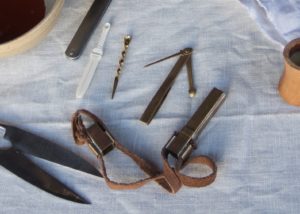
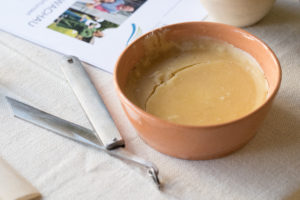
A adult female would use tweezers to remove unwanted facial hair or even use a medieval variation on modern waxing.
„Take Greek pitch and wax, and deliquesce them in a clay vessel. And these things having been dissolved, allow a modest drib of galbanum be added, [and] permit them cook for a long time, stirring with a spatula. Likewise, take mastic, frankincense, and gumarabic, and let them be mixed with the remainder. Having done this, let it be removed from the fire, and when information technology is lukewarmlet her smear her confront; but let her take care [non to touch] the eyebrows. Allow her leave it on for an hour until it becomes cold. Then let her remove it. This refines the skin and makes the face beautiful, and it removes hairs and renders every blemish well colored and clear."
And so you mix wax with different resins and gums and utilise information technology as hot equally possible to your skin. Surprisingly, some modernistic waxing mixes are withal made from wax and resins. We did however not try this recipe for obvious reasons :-)
But also leg and pubic hair was removed. We tin can run across different methods for that. Of course, y'all can shave it, as seen in this relief from the 13th century. But y'all could also tweeze the pilus when your pores are open up, for example afterward a steambath.
„ In lodge that a woman might get very soft and smooth and without hairs from her caput downwardly, first of all let her go to the baths, and if she is not accustomed to exercise and then, permit there be fabricated for her a steambath in this manner."
Subsequently you have to rub your torso thoroughly with towels and pinch out the hair.
It might exist quite a bit more than pleasant to utilize depilatory foam though. The aboriginal and medieval version of that is rhusma turcorum . The mixture consists of (quick)lime and orpiment, has been already known in antiquity and is even so in use in regions of Bharat today.
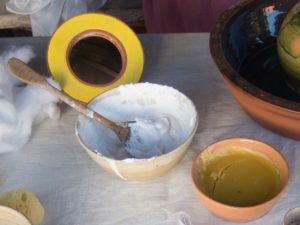
„ Afterward permit her also bless herself all over with this depilatory, which is fabricated from well-sifted quicklime. Place three ounces of it in a potter's vase and cook it in the style of a porridge.Then take i ounce of orpiment and cook it again, and test it with a feather to come across if it is sufficiently cooked."
And your hair is going to fall out for sure due to the very aggressive ingredients. The lime practically disolves some of the pilus, orpiment is toxic. So please NEVER attempt this at habitation, but use modern and prophylactic depilatories! Even medieval people knew that the use was dangerous for the skin and put a recipe for burnt peel from this depliatory right later on this recipe.
„Take care, however, that it is not cooked also much and that it non stay also long on the pare, considering it causes intense rut."
More than about historical hair removal here.
Dental hygiene:
Teeth are not left to rott in medieval times. They were cleaned with the available ways equally well as possible. At that place are some recipes for tooth powders, most of them contain rock flour, spices and salt, simply also grind walnut shells or charcoal are possible ingredients. With a damp cloth, the powder is picked up and used to rub the teeth.
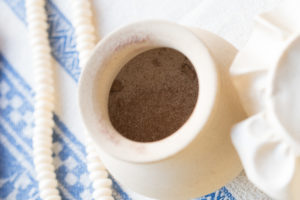
„Likewise in lodge to brand blackness teeth white, take x drams of roasted pumice,x drams of salt,two drams each of cinnamon and cloves,and honey as needed. Mix the pumice and table salt with a sufficient amount of honey, and place them on a plain dish upon coals until they burn, and reduce the other spices to a powder. And when in that location is need, rub the teeth."
Tooth powder like this is even so in use today, though much effectively and less likely to impairment your dental enamel.
Nail care:
And of course, nails are regularly clipped with scissors like in this movie from the Lilienfeld chronicles and they are cleaned with the nail cleaner which is function of well-nigh every extant hygiene set.

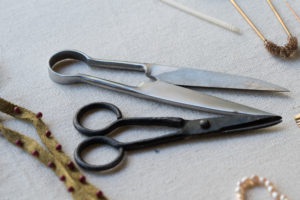
Earspoons:
I am mentionning it scince the earspoon was a very common particular. But we take not tried this tool for the love of our eardrums.

Decorative cosmetics:

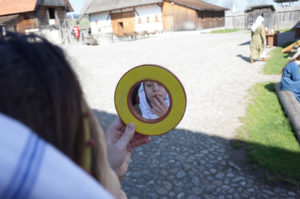
Since there are several paragraphs in the Trotula that would extend the scope of this articl, I will simply describe what I reconstructed.
Confront white:
There are several recipes for face makeup which basically consist of lead white mixed with an oily or watery liquid, in parts with wax or glue arabic to make a ameliorate consistency and make the makeup storable. I especially liked 1 where the lead is mixed with rose water and formed into beansized niggling balls which can be dissolved with rose h2o to apply. A nice idea that is a class of makeup storage notwithstanding in use today with rouge and powders. Instead of poisonous pb white, we used modern white pigments though.
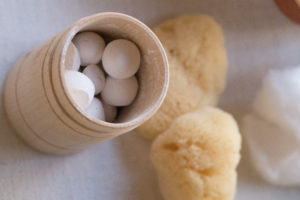
Cheekstain/Chroma:
The original recipes mix brazil wood with dissimilar liquids or greases. We tried it and failed as expected. Brazil woods red paint tin can not simply be solved in water or grease, information technology has to be turned into lac dye (maybe the writer meant just that, brazil wood lac) or mixed with alum. Some of the recipes advise the latter. Just that makes the dye unsafe for cosmetic use of grade. Nosotros used cerise ocre and it worked perfectly fine. One recipe besides uses bryony, a plant that causes a skin irritation and would therefor brand the peel cherry-red. Non a bully idea to try that out though, folks! Awarding tin be washed with a bit of cloth, cotton wool as suggested in the recipe or just the fingers.
Lip red:
One of the recipes suggests to mix bryony with honey and rose water. That would, as in the cheek stain also cause a pare irritation and make the lips read. Delight don't try this at home, bryony is poisonous! Co-ordinate to the recipes, you lot are likewise supposed to wash your lips with hot water twice a twenty-four hours and take care of them in club for them to be shine and cute. A pretty modern take on lip treatments!
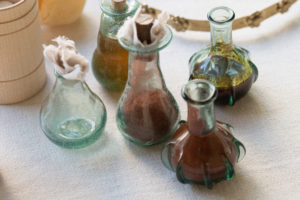
For the application of all these cosmetics, we used a mirror that Nikolaus had made for this occasion after a detect from Bavaria.
Sun screen:
Yes, you read right. A beauty-commited woman tin already avoid to accept her skin destroyed by sunburns and tan.
„ An ointment that the Salernitan women make that is very good for sunburn and fissures of whatever kind […] Take one ounce of lily root, two ounces of white pb, mastic and frankincense— of each a half dram—, ane dram of camphor, one ounce of animal grease, [and] rose water as needed. Let it be prepared thus: let the lily root, having been cleaned, be cooked in water, and once this is extracted we grind information technology thoroughly. And we pour in the fatty, which has been liquefied on the fire and well strained and cleaned of its salt in gild to dissolve information technology. Then we put in the white lead, which has been dissolved in the rose water and somewhat pulverized."
It probably is interesting to know, that fifty-fifty today, some sun screens utilize white pigment instead of chemical filters. Yes, the pigment makes your pare white. But it also shields information technology from the sun. Y'all can go rid of the skin burning and tanning UVB rays for some time. Unfortunately it does not shield you from the cancer causing and skin aging UVA rays, which is why today, chemic filters are the preferred choice.
Jewellery and clothing:
And of class, a large part of morning routine is getting dressed and putting on jewellery and veils. Here we take all that is precious and expensive from our "Minnekästchen" (an intrically worked jewellery box, often part of the dower): A circlet, prayer chaplet, a pretty fibula, rings, veil pins with pearls on them, a silk belt with silver studs and a knife with an amber handle.
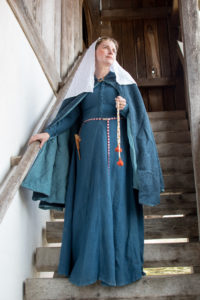
Further information:
Pinterest collection beauty and hygiene
Hair care and pilus dos in the 14th century
Youtube Video and Article on the topic of bath houses in the 14th century
A shaving comb of the 14th century
A medieval mirror – Here is the original
Dice Chirurgie des Meisters Henri de Mondeville
Eyebrows, Hairlines, and Hairs Less in Sight – Female Depilation in Late Medieval Europe, John Friedman, 2018
Excerpts from the Trotula from: https://www.amazon.de/Trotula-Translation-Medieval-Compendium-Medicine/dp/0812218086
Textual sources from "The book of the civilised man", 13th century
Bathing in the middle ages
Related Posts
The following posts might interest you also:
Source: https://wh1350.at/en/clothing/medieval-cosmetics-and-beauty-routine/
Posted by: terrellsuaing.blogspot.com

0 Response to "Can You Have Makeup In Medieval"
Post a Comment